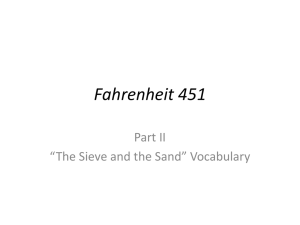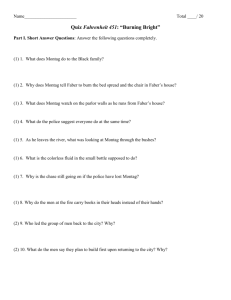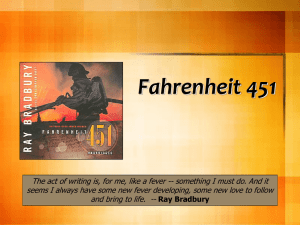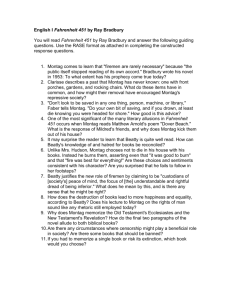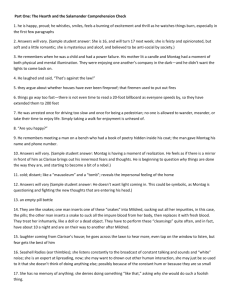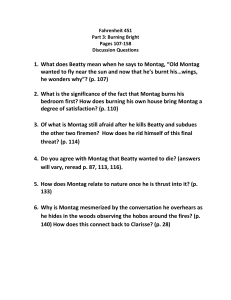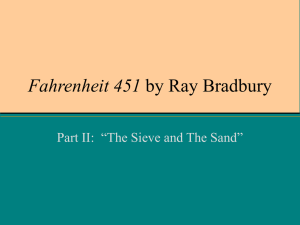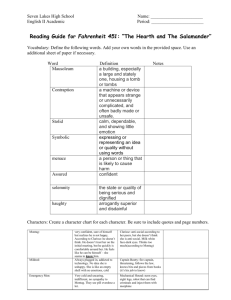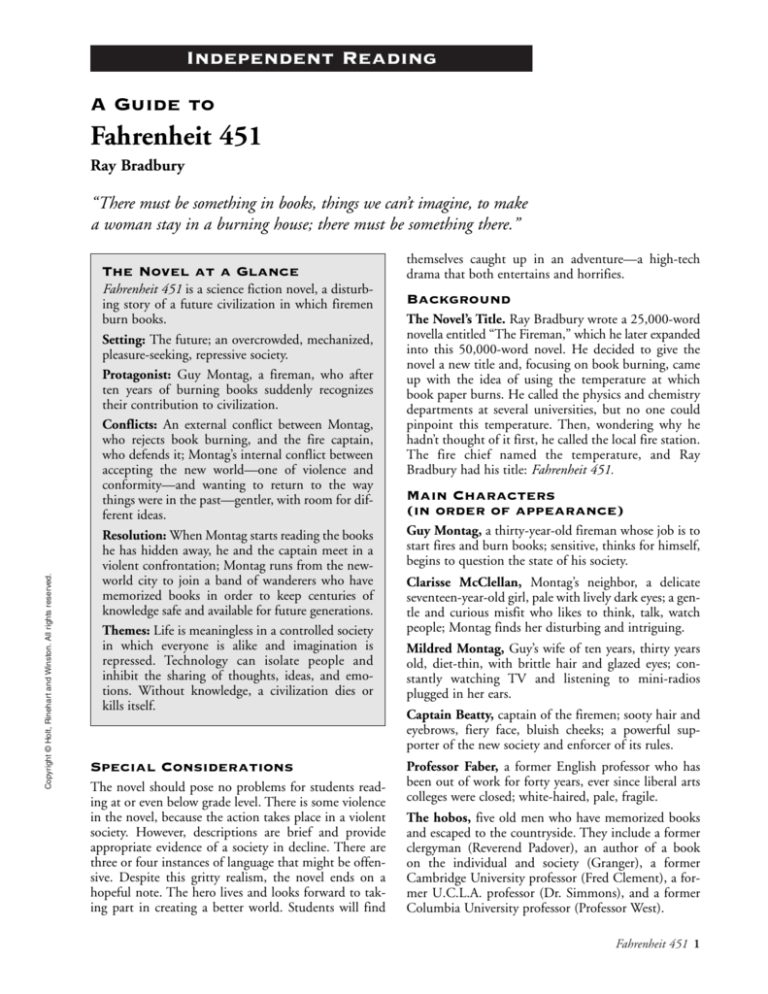
Independent Reading
A Guide to
Fahrenheit 451
Ray Bradbury
“There must be something in books, things we can’t imagine, to make
a woman stay in a burning house; there must be something there.”
Copyright © Holt, Rinehart and Winston. All rights reserved.
The Novel at a Glance
Fahrenheit 451 is a science fiction novel, a disturbing story of a future civilization in which firemen
burn books.
Setting: The future; an overcrowded, mechanized,
pleasure-seeking, repressive society.
Protagonist: Guy Montag, a fireman, who after
ten years of burning books suddenly recognizes
their contribution to civilization.
Conflicts: An external conflict between Montag,
who rejects book burning, and the fire captain,
who defends it; Montag’s internal conflict between
accepting the new world—one of violence and
conformity—and wanting to return to the way
things were in the past—gentler, with room for different ideas.
Resolution: When Montag starts reading the books
he has hidden away, he and the captain meet in a
violent confrontation; Montag runs from the newworld city to join a band of wanderers who have
memorized books in order to keep centuries of
knowledge safe and available for future generations.
Themes: Life is meaningless in a controlled society
in which everyone is alike and imagination is
repressed. Technology can isolate people and
inhibit the sharing of thoughts, ideas, and emotions. Without knowledge, a civilization dies or
kills itself.
Special Considerations
The novel should pose no problems for students reading at or even below grade level. There is some violence
in the novel, because the action takes place in a violent
society. However, descriptions are brief and provide
appropriate evidence of a society in decline. There are
three or four instances of language that might be offensive. Despite this gritty realism, the novel ends on a
hopeful note. The hero lives and looks forward to taking part in creating a better world. Students will find
themselves caught up in an adventure—a high-tech
drama that both entertains and horrifies.
Background
The Novel’s Title. Ray Bradbury wrote a 25,000-word
novella entitled “The Fireman,” which he later expanded
into this 50,000-word novel. He decided to give the
novel a new title and, focusing on book burning, came
up with the idea of using the temperature at which
book paper burns. He called the physics and chemistry
departments at several universities, but no one could
pinpoint this temperature. Then, wondering why he
hadn’t thought of it first, he called the local fire station.
The fire chief named the temperature, and Ray
Bradbury had his title: Fahrenheit 451.
Main Characters
(in order of appearance)
Guy Montag, a thirty-year-old fireman whose job is to
start fires and burn books; sensitive, thinks for himself,
begins to question the state of his society.
Clarisse McClellan, Montag’s neighbor, a delicate
seventeen-year-old girl, pale with lively dark eyes; a gentle and curious misfit who likes to think, talk, watch
people; Montag finds her disturbing and intriguing.
Mildred Montag, Guy’s wife of ten years, thirty years
old, diet-thin, with brittle hair and glazed eyes; constantly watching TV and listening to mini-radios
plugged in her ears.
Captain Beatty, captain of the firemen; sooty hair and
eyebrows, fiery face, bluish cheeks; a powerful supporter of the new society and enforcer of its rules.
Professor Faber, a former English professor who has
been out of work for forty years, ever since liberal arts
colleges were closed; white-haired, pale, fragile.
The hobos, five old men who have memorized books
and escaped to the countryside. They include a former
clergyman (Reverend Padover), an author of a book
on the individual and society (Granger), a former
Cambridge University professor (Fred Clement), a former U.C.L.A. professor (Dr. Simmons), and a former
Columbia University professor (Professor West).
Fahrenheit 451 1
In Part One we follow the thoughts and actions of the
protagonist, Montag, at home and at work as he begins
to ask himself the questions about his life that will form
the conflict of the novel. The setting is the unspecified
future, when firemen like Montag start rather than stop
fires—when books are meant to be burned, along with
the houses they are found in. At first Montag is a man
taking great delight in burning, a man who enjoys his
work and accepts the rules of his world. But on his way
home one evening, he meets a young neighbor,
Clarisse. Her talk about the days when firemen used to
stop fires, and her curiosity about the past and the
meaning of happiness, dismay and alarm him.
Montag arrives at his cold, sterile home to find his
wife, Mildred, sleeping with a miniature radio in each
ear. Finding an empty pill bottle, he realizes that
Mildred has overdosed. He calls the emergency hospital, and two unsympathetic machine operators pump
her stomach, drain her blood, and replace it. Sitting
alone, Montag hears laughter and conversation coming
from Clarisse’s house next door. He steps outside to listen and realizes for the first time that he is not happy.
At the firehouse, Montag is wary of the firemen’s
“pet,” a Mechanical Hound equipped with a needlenose that can inject deadly chemicals. Recently, the
Hound has acted angrily toward him—and Montag
fears that someone has programmed the Hound to go
after him. This scene foreshadows trouble to come.
For several days, Clarisse walks Montag to the subway,
asking questions and sharing her observations. These conversations make Montag nervous and confused. Then one
day Clarisse is gone, and Montag realizes he misses her.
Later, someone calls the firehouse to report that there
are books in the attic of a neighboring house. The firemen find a woman in the house. She will not leave.
Laughing, the men ignite mounds of books, pump
kerosene into the rooms, and burn down the house—
along with the woman. Witnessing the woman’s death
and her choice to burn with her books is a turning point
for Montag. He hides one of her books under his arm.
At home that night, Montag learns that Clarisse is
probably dead and that the family has moved. The next
morning, Montag thinks about the woman who was
burned, and he becomes sick with grief and repugnance. He wants to quit his job. His superior, Captain
Beatty, comes to see Montag and lectures him on the
history of their profession and the importance of burning books to ensure that everyone will be alike.
Intellectuals and readers of books, he explains, were
hated because they were different. Moreover, Beatty
knows that Montag has a book; he tells him he can keep
it for twenty-four hours, after which he must burn it.
This incident signals Montag’s conflict with Beatty.
After Beatty leaves, Montag defiantly collects some
twenty books he has hidden in the air-conditioning system, stops Mildred from tossing them into the incinerator, and begins to read.
2 Fahrenheit 451
Part Two signals further changes in the protagonist as he
begins to act on his new ideas. At home he tries to read
to Mildred, but she prefers the noise and color of TV. He
remembers meeting a retired English professor, Faber,
who talked about the meaning of things. He calls
Professor Faber and asks how many copies of the Bible
are left. Montag discovers that the copy he has hidden
may be one of the last few in the world. When he finds
that he is unable to read and understand it, Montag goes
to Faber’s house, where the professor reluctantly agrees to
teach him to understand what he reads. Faber also confesses that he did nothing early on to stop the burning of
books. Finally, the professor shows Montag a miniature
ear radio, a “green bullet,” that he has designed. Those
who wear these radios can listen and talk to one another.
After giving Montag a green bullet, Faber offers to help
his new ally deal with Beatty.
As Montag walks home from the subway, he hears
that the country is mobilizing for yet another war. At
home he finds Mildred watching TV with her friends.
Montag suggests they talk instead. Appalled by their
shallowness, he reacts by reading poetry to them.
Mildred, in turn, calls him a fool.
Hour after hour, Faber talks to Montag on the bullet
radio, encouraging him not to be afraid of learning, of
making mistakes. Through the bullet, he is with Montag
at home, on the subway, at the firehouse. Montag, nervous, returns a book to Beatty. Beatty tells him about a
dream he had in which he and Montag debate about the
value of books, and Beatty wins all the arguments, proving that books can’t be trusted. Montag feels sick and
confused. Suspense builds as the station alarm rings and
the Mechanical Hound is found to be missing from the
firehouse. Beatty says that there is no need to hurry in
answering the alarm, that this one is a special case. The
special case turns out to be Montag’s house.
In Part Three, Montag takes the final steps that resolve
the conflicts in the novel. When he arrives at his house, he
sees Mildred, clutching a suitcase, speed off in a waiting
taxi. It was she who turned him in. Beatty now orders
Montag to burn down his own house—and to do it slowly
by using the flame thrower. Faber, still in Montag’s ear, tells
him to run, but Montag is afraid of the Hound. After setting his own house on fire, he’s arrested by Beatty.
Suddenly Beatty strikes Montag and the ear radio falls out.
Beatty picks it up and threatens to trace the radio. Montag
screams “No,” aims the flame thrower, and liquefies the
Captain. Then the Hound appears and stabs Montag in
the leg; Montag, in turn, destroys the metal dog.
Police sirens wail. The pain in his leg is excruciating,
but Montag stumbles into an alley. He remembers the
books hidden in his yard and goes back to find them. He
finds four books and, after holding them, summons the
strength to get away. Montag’s decision to go back for the
books and to run is an important turning point for him.
With great effort, Montag makes it to a gas station
and washes up in the men’s room. There he hears a
radio announcement that war has been declared.
Copyright © Holt, Rinehart and Winston. All rights reserved.
Plot
Copyright © Holt, Rinehart and Winston. All rights reserved.
After a painful flight and a near accident, Montag
finally reaches Faber’s door. Faber advises Montag to
escape into the countryside and go to the hobo camps.
After turning on Faber’s tiny TV, they hear that the
police are hunting for Guy Montag, using the
Mechanical Hound to help with the search. Montag,
preparing to leave, asks Faber for some dirty old clothes
and tells the professor to get rid of his—Montag’s—scent in the house. Then he runs.
The chase is on. Montag is running, running from
the Mechanical Hound, running to the river. The
police order all people to open their doors and look for
Guy Montag. Fortunately, Montag makes it to the river,
changes into Faber’s clothes, and floats downstream.
When the Hound reaches the river, Montag is gone.
The river carries him to shore, where he is engulfed
by comforting country smells. Finding a rusty railroad
track, Montag follows it, sensing that Clarisse once
walked there. In time, he comes upon a group of
men—the hobos—warming their hands before a fire.
They welcome him. They explain that they know who
he is from TV. One of the men switches on their battery TV, and they see what the police are up to. Because
they can’t admit that Montag escaped, the police have
the Mechanical Hound attack an innocent pedestrian,
declare the man is Montag, and announce that he’s dead.
Montag is introduced to the men: a clergyman
(Reverend Padover), an author (Granger), and three professors (Fred Clement, Dr. Simmons, and Professor
West). They and thousands of others have each memorized a great book. He’s invited to join them—if he
has something to offer. Montag offers the Book of
Ecclesiastes.
There is a thunder of jets; bombs strike, and in seconds the war is over. The city is gone. Yet the novel ends
with hope. Those who have memorized books live on.
They will be careful and will pass on the books by word
of mouth. They will wait until people are ready to listen. Montag has become one of them.
Approaches for
Post-Reading Activities
Because the conflicts in this novel are struggles of an
individual against a whole society, the book might be
discussed in a social studies or history course that
focuses on sociology or systems of government.
Although fictional, the repressive civilization depicted
is quite believable. The following activities can be
explored in cooperative groups or by students working
independently on research projects.
1. Technology Today
A major theme of Fahrenheit 451 is that technology
can isolate people and inhibit the sharing of
thoughts, ideas, and emotions. Students working in
groups could make a list of the current technology
that is part of everyday life, such as videocassette
recorders, computers, answering machines, mobile
phones, and portable tape players with headphones.
They could discuss the impact of each invention on
society and report on their conclusions to the class.
• How has the invention changed interpersonal
relationships?
• What has the invention replaced? For better or
for worse?
• Why do we need to learn to control technology?
How might we start?
2. Joining the Wanderers
Have students imagine they have joined the wandering group of book lovers. What great book has each
student committed to memory? Have students discuss their selections and defend their choices in
terms of the book’s meaning and the contribution it
can make to a better world.
3. Comparing and Contrasting Novel and Film
Students interested in film could watch François
Truffaut’s film version of Fahrenheit 451 (1967). They
should compare the film’s interpretation of the story
with Bradbury’s, focusing on the following elements:
• setting—futuristic aspects, mood
• characters—appearance, personalities, values
• action—level of violence, use of suspense
4. Could It Happen? Relating the Novel to Real Life
For many readers, this novel brings to mind the book
burning that took place in Nazi Germany. Students
could present a panel discussion on why the Nazis
burned books and what this suggests about the
power of the word. Do book burnings still take place
around the world today? Ask students to consider
issues of censorship. When is it necessary? What are
its effects? Who has the right to act as censor?
Meet the Writer
Ray Bradbury (1920– ) began writing when he was
seven years old. He was born in Waukegan, Illinois, and
lived, he says, immersed in a world of fantasy and illusion—the world of the comic strip characters Buck
Rogers and Flash Gordon. In high school, he founded
and edited a magazine called Futuria Fantasia, which he
ran off on a mimeograph. After graduating from high
school, Bradbury wrote stories that didn’t sell and supported himself by selling newspapers in downtown Los
Angeles. At the age of twenty-three, he became a fulltime writer.
Bradbury explains that his hatred of thought investigation and thought control of any kind arises from the
fact that his ancestor, Mary Bradbury, was tried as a
witch in Salem, Massachusetts, during the seventeenth
century. According to Bradbury, “Science fiction is a
wonderful hammer; I intend to use it when and if necessary to bark a few shins or knock a few heads, in order
to make people leave people alone.”
Fahrenheit 451 3
Read On
Ray Bradbury, Dandelion Wine. A literary classic
about boyhood, this novel is both imaginative and realistic. Douglas Spaulding, twelve years old, experiences a
summer of wonder and wisdom as he moves on from
childhood. It is 1928 in Green Town, Illinois, and
Douglas suddenly realizes it’s great to be alive. He
embraces the ordinary and the extraordinary: trolley
cars, rain barrels, dandelion wine, the Happiness
Machine, and the Time Machine.
Kurt Vonnegut, “Harrison Bergeron.” The future
again—but this time everyone must by law be “equal”
or the same. This short story uses satire and humor to
show one person fighting back.
Ray Bradbury, “The Pedestrian.” Set in an ominous
future, this short story leaves the reader wondering
about the uses of technology.
Edgar Allan Poe, “The Pit and the Pendulum.” An
extraordinary tale of horror set in another totalitarian
society.
Sophocles, Antigone. A play from ancient Greece that
explores the individual conscience at odds with established authority.
Martin Luther King, Jr., “Letter from Birmingham
Jail.” A powerful letter written by the American civil
rights leader from his prison cell in 1963.
Copyright © Holt, Rinehart and Winston. All rights reserved.
Tom Godwin, “The Cold Equations.” A suspenseful
short story, set in a technological future, about a hard
decision and its dreadful consequences.
Copyright © by Holt, Rinehart and Winston, Inc.
All rights reserved. No part of this publication may be reproduced
or transmitted in any form or by any means, electronic
or mechanical, including photocopy, recording, or any information
storage and retrieval system.
Printed in the United States of America
4 Fahrenheit 451

